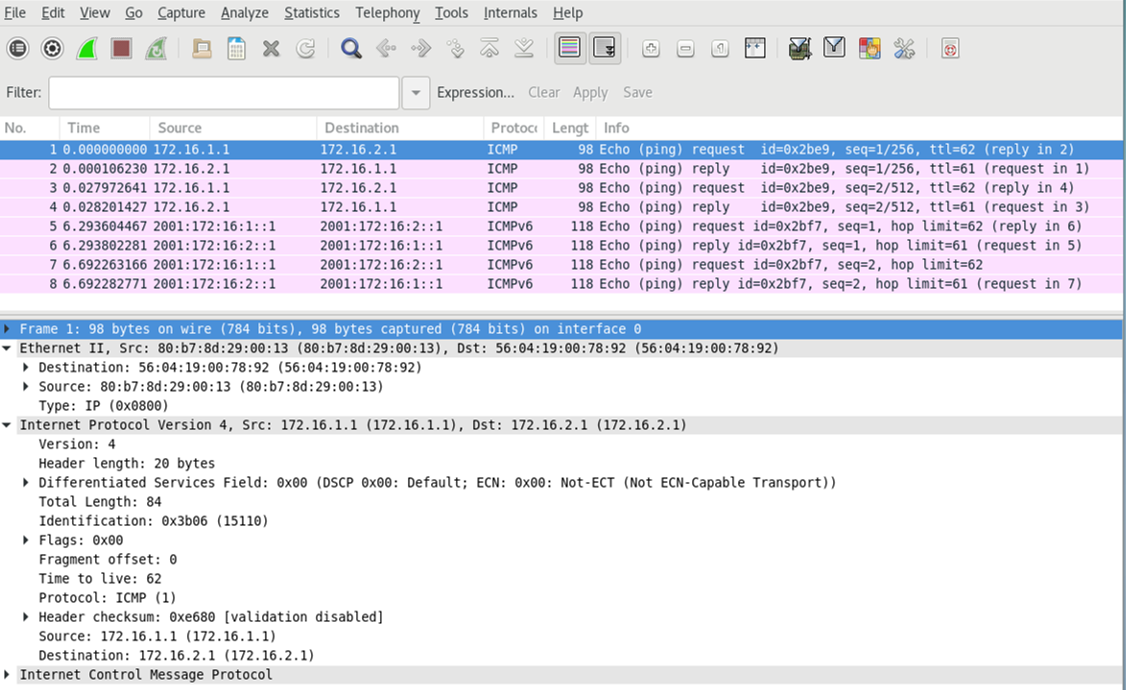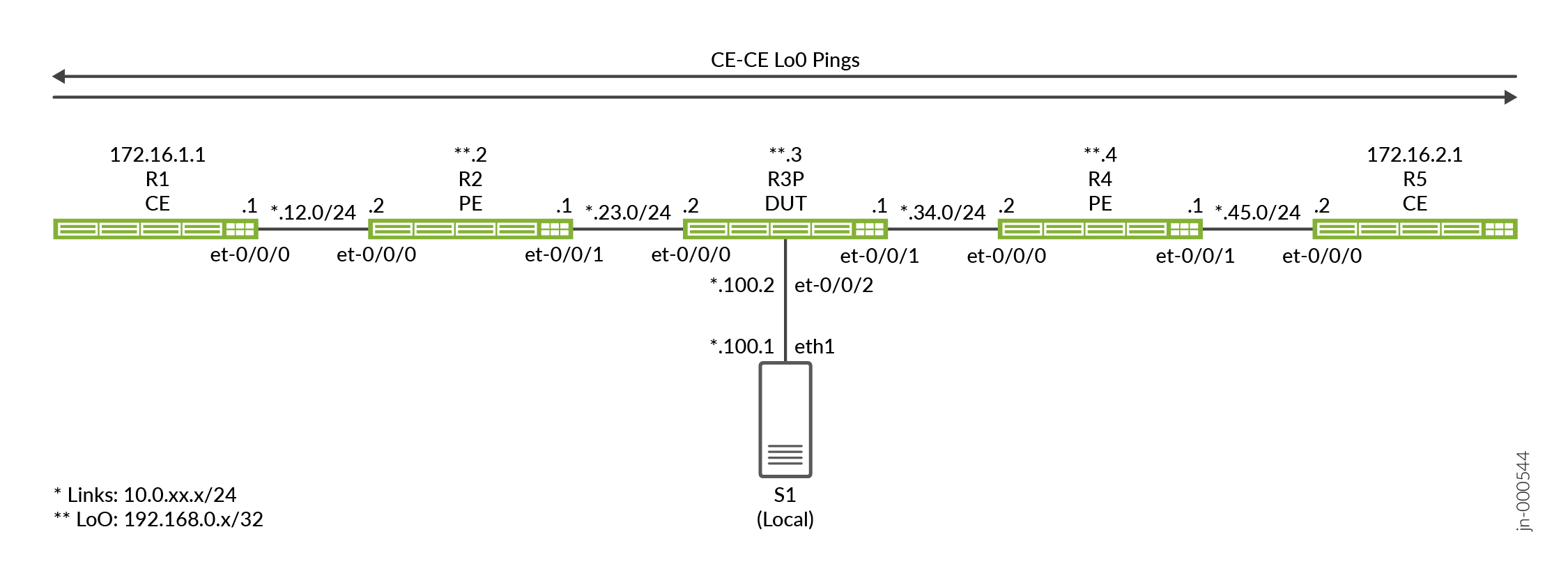- play_arrow 概要
- play_arrow ネットワーク監視のためのトラフィックサンプルの収集
- トラフィック サンプリング設定
- 最小トラフィックサンプリング設定
- トラフィック サンプリングの設定
- トラフィック サンプリングの無効化
- ファイル内のトラフィック サンプリング出力の収集
- トラフィックサンプリング出力をcflowdアプリケーションを実行しているサーバーに送る
- Cisco Systems NetFlow サービス エクスポート バージョン 9 形式でのトラフィック サンプリング出力の収集
- 例:単一の SONET/SDH インターフェイスのサンプリング
- 例:単一 IP アドレスからの全トラフィックのサンプリング
- 例:すべての FTP トラフィックのサンプリング
- トラフィックサンプリング動作のトレース
- play_arrow トラフィックを効率的にルーティングするための転送テーブルフィルターの設定
- play_arrow 負荷分散トラフィックの転送オプションの設定
- イーサネット擬似配線の負荷分散の設定
- 負荷分散グループの設定
- MXシリーズルーターでトラフィックの負荷分散に使用されるアルゴリズムを理解する
- パケット単位のロードバランシングを理解する
- パケット単位のロードバランシングの設定
- フロー単位のロード バランシングの設定
- パスに割り当てられた不等な帯域幅とBGPトラフィックのロードバランシングの理解
- パケットトランスポートルーター(PTXシリーズ)のデフォルトBGPルーティングポリシーの理解
- ACXシリーズルーターでのECMPフローベースの転送
- フロー単位とプレフィックス単位のロードバランシングの概要
- プレフィックス単位のロード バランシングの設定
- ハッシュ値に基づくフロー単位のロード バランシングの設定
- MACアドレスに基づくロード バランシングの設定
- 集約インターフェイスのメンバーリンク間のVPLS非ユニキャストトラフィックのロードバランシング
- 例:集約されたイーサネット リンク上のマルチキャスト ロード バランシングの設定
- play_arrow その他の転送オプションの設定
- play_arrow 設定ステートメントと運用コマンド
例:PTXルーターでのローカルポートミラーリングの設定
この例では、Junos Evolvedが稼働するPTXプラットフォームでローカルポートミラーリングを構成および検証する方法を示します。PTXプラットフォームには、PTX10004、PTX10008、PTX10016シャーシにPTX10001-36MR、LC1201、LC1202が含まれます
始める前に
| ハードウェア要件とソフトウェア要件 | Junos OS Evolvedリリース22.2R1.12-EVO以降。 PTX10001-36MR サポートされているプラットフォームと Junos OS バージョンの完全なリストについては、 機能エクスプローラーを参照してください。 |
推定読書時間 | 15分。 |
推定構成時間 | 30分 |
ビジネスへの影響 | この設定例を使用して、ローカル ポート ミラーリング機能を設定します。ポートミラーは、デバッグやセキュリティ関連のタスクに不可欠なツールです。ミラートラフィックは、さまざまなツールでオフラインで分析し、プロトコルの相互作用を確認したり、異常を検出したりできます。 |
もっと知る | ポートミラーリングの詳細については、ポートミラーリングとアナライザを参照してください |
詳細情報 | ラーニングポータル |
機能概要
表1 は、この例で導入されたプロトコルと技術の概要を示しています。
ルーティングおよびシグナリングプロトコル | |
OSPF および OSPF3 | すべてのルーターは、OSPFとOSPF3をIGPとして実行します。すべてのルーターは、エリア 0(バックボーン エリアとも呼ばれる)に属します。OSPF/OSPF3ルーティングドメインは、トポロジー内のすべてのネットワークとインターフェイスに内部到達可能性を提供します。 この例では、CEデバイスとPE/Pデバイスは、同じIGPルーティングドメインの一部です。その結果、コアを介してCEトラフィックを伝送するためにPEデバイス間にトンネルは必要ありません。また、これはローカルミラーのユースケースであるため、ミラーリングされたトラフィックを監視ステーションに送信する際に、GREカプセル化は必要ありません。 |
ルーティングプロトコル | |
IPv4 および IPv6 | すべてのデバイスは、IPv4 と IPv6 の両方のルーティングをサポートするように構成されています。 |
アナライザ(監視ステーション) | |
CentosとWireshark | このアナライザーは、WiresharkのGUIバージョンでCentos 7.xを実行します。 |
トポロジの概要
この例では、R3デバイスはポートミラーリングが設定されている被試験デバイス(DUT)として機能します。デバイスは、ファイアウォールフィルターを使用してCEデバイスに関連するIPアドレスを照合し、ポートミラーアクションをトリガーします。イングレス フィルターとエグレス フィルターを組み合わせて採用し、CE デバイス(R1 と R5)間を流れる要求トラフィックと応答トラフィックの両方をミラーリングします。
パケット サンプリングを呼び出すファイアウォール フィルターは、R3 デバイス上の 1 つ以上のトランジット インターフェイスに適用されます。
| デバイス名 | 役割 | 関数 |
| Ce | サンプリングが正しく動作することを確認するためにテストトラフィックを送信するCE(カスタマーエッジ)デバイス。 | これらの装置は CE 装置として指定されます。ほとんどの場合、CEデバイスはVPNサービスの一部です。ここでは、CEにプロバイダーデバイスと同じOSPFエリア0を共有して、メインインスタンスのIP接続を提供します。 |
| Pe | CE に接続する PE(プロバイダ エッジ)デバイス。 | プロバイダーネットワークのエッジにあるデバイス。当社のPEはOSPFのみを実行します。BGPとVPNは導入されていません。 |
| P | プロバイダー(P)コア ルーター。 | ここでは、P ルーターでのポート ミラーリングのデモを行います。必要に応じて、任意のプロバイダーデバイスでポートミラーリングを設定できます。 |
| アナライザー | アナライザ デバイスは、保存と分析のためにミラー トラフィックを受信しました。 | アナライザーの詳細は、このドキュメントの範囲外です。利用可能なオープンソースおよび商用オプションがいくつかあります。私たちのアナライザーは、WiresharkのGUIOバージョンをサポートするGnomeデスクトップでCentos 7.xを実行しています。 |
R3 の設定手順
CLIのナビゲーションについては、 設定モードでのCLIエディタの使用を参照してください
すべてのデバイスでの完全な設定については、「付録 2: すべてのデバイスでコマンドを設定する」を参照してください。
このセクションでは、DUT(この例ではPデバイス(R3))の設定に必要な主な設定タスクについて説明します。サンプリングに使用される詳細を除き、すべてのデバイスには、メイン インスタンスの IPv6 および IPv4 接続をサポートする同様のベースライン構成があります。
IPv4 および IPv6 ルーティング ベースラインを構成します。これには、IPv4 と IPv6 の両方のループバック インターフェイスとコア フェーシング インターフェイスの番号付けが含まれます。また、OSPF および OSPFv3 ルーティング プロトコルを定義して、すべてのネットワーク インターフェイス間の到達可能性を提供します。
パッシブIGPインスタンスは、アナライザに接続されたインターフェイス用にプロビジョニングされます。これにより、インターフェイス上で hello パケットを生成することなく、診断目的の到達可能性を提供します。OSPF 隣接関係は、アナライザ デバイスに想定されていないか、必要ではありません
content_copy zoom_out_map[edit] set interfaces et-0/0/0 unit 0 family inet address 10.0.23.2/24 set interfaces et-0/0/0 unit 0 family inet6 address 2001:db8:10:0:23::2/64 set interfaces et-0/0/1 unit 0 family inet address 10.0.34.1/24 set interfaces et-0/0/1 unit 0 family inet6 address 2001:db8:10:0:34::1/64 set interfaces et-0/0/2 unit 0 family inet address 10.0.100.2/24 set interfaces et-0/0/2 unit 0 family inet6 address 2001:db8:10:0:100::2/64 set interfaces lo0 unit 0 family inet address 192.168.0.3/32 set interfaces lo0 unit 0 family inet6 address 2001:db8:192:168:0::3/128 set routing-options router-id 192.168.0.3 set protocols ospf area 0.0.0.0 interface all set protocols ospf area 0.0.0.0 interface fxp0.0 disable set protocols ospf area 0 interface et-0/0/2.0 passive set protocols ospf3 area 0.0.0.0 interface all set protocols ospf3 area 0.0.0.0 interface fxp0.0 disable set protocols ospf3 area 0 interface et-0/0/2.0 passive
メモ:ローカルミラーのユースケースでは、IP接続はアナライザとポートミラーリングを実行するデバイス間でのみ必要です。この例では、アナライザに接続されたインターフェイスでパッシブIGPを実行します。また、アナライザーにデフォルトルートを構成して、アナライザーと他のデバイス間のIP接続を提供します。これにより、アナライザと他のすべてのデバイス間の接続をテストできます。トポロジーで実行に移ります。この機能は、サンプリング デバイスとアナライザ間のレイヤー 3 到達可能性を必要とするリモート ポート ミラーの場合に最も役立ちます。
- サンプリングレートを設定します。レート1を使用して、一致するすべてのパケットを選択してサンプリングします。デフォルトの
run-length0は、一致するすべてのトラフィックがすでにサンプリングされている場合にそのまま残されます。ミラーリングされたトラフィックの送信先のエグレスインターフェイスとネクストホップアドレスも指定する必要があります。このローカルポートミラーの例では、指定されたインターフェイスとネクストホップアドレスがDUTに直接接続されていることに注意してください。その結果、ミラーリングされたトラフィックをアナライザに送信するときにトンネルは不要になり、使用されません。content_copy zoom_out_map[edit] set forwarding-options port-mirroring input rate 1 set forwarding-options port-mirroring family inet output interface et-0/0/2.0 next-hop 10.0.100.1 set forwarding-options port-mirroring family inet6 output interface et-0/0/2.0 next-hop 2001:db8:10:0:100::1
メモ:この構成では、MACアドレス解決のためにDUTから送信されたARPおよびND要求にアナライザが応答することを前提としています。そうでない場合、または ARP トラフィックをパケット キャプチャの一部にしたくない場合は、スタティック ARP エントリを設定する必要があります。DUTに接続されているアナライザデバイスのインターフェイスに正しいMACアドレスを指定してください。
IPv4 パケットで照合する ファイアウォール フィルターを定義し、IPv4 パケットをミラーリングします。フィルターのアクションは、ポートミラーアクションを指定することに注意してください。このアクションにより、一致するトラフィックが、以前に設定したポートミラーリングインスタンスに送信されます。CE1 と CE2 の送信元アドレスと宛先アドレスにそれぞれ 1 つずつ、合計 2 つのフィルターが定義されています。フィルターには、適切な動作の確認を支援するカウント機能が含まれています。
Junosファイアウォールフィルターのデフォルト
deny-allアクションを上書きする最後のaccept-all用語を見落とさないでください。content_copy zoom_out_map[edit] set firewall filter mirror_ce1 term term1 from source-address 172.16.1.1/32 set firewall filter mirror_ce1 term term1 from destination-address 172.16.2.1/32 set firewall filter mirror_ce1 term term1 then count mirror_ce1 set firewall filter mirror_ce1 term term1 then port-mirror set firewall filter mirror_ce1 term term1 then accept set firewall filter mirror_ce1 term accept-all then accept set firewall filter mirror_ce2 term term1 from source-address 172.16.2.1/32 set firewall filter mirror_ce2 term term1 from destination-address 172.16.1.1/32 set firewall filter mirror_ce2 term term1 then count mirror_ce2 set firewall filter mirror_ce2 term term1 then port-mirror set firewall filter mirror_ce2 term term1 then accept set firewall filter mirror_ce2 term accept-all then accept
IPv6 パケットを照合してミラーリングするファイアウォールフィルターを定義します。
content_copy zoom_out_map[edit] set firewall family inet6 filter ce1_v6 term 1 from source-address 2001:db8:172:16:1::1/128 set firewall family inet6 filter ce1_v6 term 1 from destination-address 2001:db8:172:16:2::1/128 set firewall family inet6 filter ce1_v6 term 1 then count ce1_v6 set firewall family inet6 filter ce1_v6 term 1 then port-mirror set firewall family inet6 filter ce1_v6 term 1 then accept set firewall family inet6 filter ce1_v6 term accept-all then accept set firewall family inet6 filter ce2_v6 term 1 from source-address 2001:db8:172:16:2::1/128 set firewall family inet6 filter ce2_v6 term 1 from destination-address 2001:db8:172:16:1::1/128 set firewall family inet6 filter ce2_v6 term 1 then count ce2_v6 set firewall family inet6 filter ce2_v6 term 1 then port-mirror set firewall family inet6 filter ce2_v6 term 1 then accept set firewall family inet6 filter ce2_v6 term accept-all then accept
IPv4およびIPv6フィルターを目的のインターフェイスに適用します。この例では、両方のフィルターをet-0/0/0インターフェイスに適用します。フィルター アプリケーションの方向性に注意してください。CEトラフィックフロー(IPv4またはIPv6)ごとに、1つのフィルターをingressとして適用し、もう1つのフィルターをegressとして適用します。この適用方法は、アドレスの割り当てとトラフィックの方向性を考慮して、フィルターが書き込まれる方法と互換性があります。
content_copy zoom_out_map[edit] set interfaces et-0/0/0 unit 0 family inet filter input mirror_ce1 set interfaces et-0/0/0 unit 0 family inet filter output mirror_ce2 set interfaces et-0/0/0 unit 0 family inet6 filter input ce1_v6 set interfaces et-0/0/0 unit 0 family inet6 filter output ce2_v6
検証
OSPF および OSPF3 ネイバーを確認し、すべてのループバック アドレスにルートします。
content_copy zoom_out_mapuser@r3-ptx> show ospf neighbor Address Interface State ID Pri Dead 10.0.23.1 et-0/0/0.0 Full 192.168.0.2 128 31 10.0.34.2 et-0/0/1.0 Full 192.168.0.4 128 38 user@r3-ptx> show ospf3 neighbor ID Interface State Pri Dead 192.168.0.2 et-0/0/0.0 Full 128 30 Neighbor-address fe80::c6ba:25ff:fe48:9 192.168.0.4 et-0/0/1.0 Full 128 32 Neighbor-address fe80::6204:30ff:fe6e:ffff regress@r3-ptx> show route protocol ospf | match /32 172.16.1.1/32 *[OSPF/10] 01:04:02, metric 2 172.16.2.1/32 *[OSPF/10] 6d 00:47:07, metric 2 192.168.0.2/32 *[OSPF/10] 01:04:02, metric 1 192.168.0.4/32 *[OSPF/10] 6d 00:47:12, metric 1 224.0.0.5/32 *[OSPF/10] 6d 00:48:28, metric 1 224.0.0.6/32 *[OSPF/10] 6d 00:48:28, metric 1 regress@r3-ptx> show route protocol ospf3 | match /128 2001:db8:172:16:1::1/128 2001:db8:172:16:2::1/128 2001:db8:192:168::2/128*[OSPF3/10] 01:04:09, metric 1 2001:db8:192:168::4/128*[OSPF3/10] 6d 00:47:15, metric 1 ff02::5/128 *[OSPF3/10] 6d 00:48:35, metric 1 ff02::6/128 *[OSPF3/10] 6d 00:48:35, metric 1
R3のポートミラーリングインスタンスを確認します。ポートミラーリングの状態が
upミラーリングインターフェイスの状態であることを確認します。IPv4 ファミリと IPv6 ファミリの両方の状態を必ず確認してくださいup。ここで、DUTとアナライザ間のIP接続を確認することをお勧めします。私たちのセットアップでは、ネットワークのすべてのポイントからのpingテストを許可するために、アナライザにデフォルトルートが設定されています。技術的には、DUT(R3)がアナライザに到達できていればよいのはローカルポートミラーリングの例です。content_copy zoom_out_mapuser@r3-ptx> show forwarding-options port-mirroring Instance Name: &global_instance Instance Id: 1 Input parameters: Rate : 1 Run-length : 0 Maximum-packet-length : 0 Output parameters: Family State Destination Next-hop inet up et-0/0/2.0 10.0.100.1 inet6 up et-0/0/2.0 2001:db8:10:0:100::1R3 のファイアウォール カウンターとインターフェイス統計情報をクリアします。次に、CEデバイス間でIPv4およびIPv6のテストトラフィックを生成し、R3にファイアウォールカウンターを表示します。R3に適用されたフィルターがテストトラフィックを正しく反映していることを確認します。
content_copy zoom_out_mapuser@r3-ptx> clear firewall all user@r3-ptx> clear interfaces statistics all
content_copy zoom_out_mapuser@r1-ptx> ping 172.16.2.1 source 172.16.1.1 count 10 rapid PING 172.16.2.1 (172.16.2.1) from 172.16.1.1 : 56(84) bytes of data. --- 172.16.2.1 ping statistics --- 10 packets transmitted, 10 received, 0% packet loss, time 711ms rtt min/avg/max/mdev = 11.161/72.078/364.497/121.714 ms, ipg/ewma 78.945/100.962 ms user@r1-ptx> ping 2001:db8:172:16:2::1 source 2001:db8:172:16:1::1 count 10 rapid ping 2001:db8:172:16:2::1 source 2001:db8:172:16:1::1 count 10 rapid PING 2001:db8:172:16:2::1(2001:db8:172:16:2::1) from 2001:db8:172:16:1::1 : 56 data bytes --- 2001:db8:172:16:2::1 ping statistics --- 10 packets transmitted, 10 received, 0% packet loss, time 2436ms rtt min/avg/max/mdev = 11.363/247.188/518.314/226.132 ms, pipe 2, ipg/ewma 270.652/201.439 ms
R3のファイアウォールカウンターを表示します。R3に適用されたフィルターが、生成したテストトラフィックを正しく反映しているかどうかを確認します。
content_copy zoom_out_mapuser@r3-ptx> show firewall Filter: mirror_ce1 Counters: Name Bytes Packets mirror_ce1 840 10 Filter: mirror_ce2 Counters: Name Bytes Packets mirror_ce2 840 10 Filter: ce1_v6 Counters: Name Bytes Packets ce1_v6 1040 10 Filter: ce2_v6 Counters: Name Bytes Packets ce2_v6 1040 10
アナライザに接続されているR3のet-0/0/2.0インターフェイスのインターフェイス統計情報を表示します。目的は、生成されたテスト トラフィックと相関する出力トラフィック カウンターを確認することです。IPv4 と IPv6 の両方で 10 回の ping を実行し、要求と応答の両方をミラーリングすると、約 40 個の出力パケットが表示されることが予想されます。
content_copy zoom_out_mapuser@r3-ptx> show interfaces et-0/0/2.0 detail Logical interface et-0/0/2.0 (Index 1017) (SNMP ifIndex 541) (Generation 704374637676) Flags: Up SNMP-Traps Encapsulation: ENET2 Traffic statistics: Input bytes : 0 Output bytes : 3760 Input packets: 0 Output packets: 40 Local statistics: Input bytes : 0 Output bytes : 0 Input packets: 0 Output packets: 0 Transit statistics: Input bytes : 0 0 bps Output bytes : 3760 0 bps Input packets: 0 0 pps Output packets: 40 0 ppstcpdumpまたは任意の分析アプリケーションを監視ステーションで実行し、ミラーリングされたテストトラフィックの受信と処理を確認します。キャプチャのサイズを小さく保つために、IPv4 と IPv6 ごとに 2 つの ping リクエストのみで新しいテスト トラフィックを生成しました。キャプチャとデコードにより、ファイアウォールフィルターのマッチングに基づいて、IPv4とIPv6のポートミラーリングが期待通りに動作していることを確認します。要求トラフィックと応答トラフィックの両方が表示されることに注意してください。
また、キャプチャでは、レイヤー3トラフィックのみがミラーリングされていることに注意してください。示されているレイヤー2カプセル化は、ミラーリングされたトラフィックをアナライザに転送する際に、DUT(R3)によって生成されます。元のレイヤー 2 フレームを保持する必要がある場合は、イーサネット スイッチングや VXLAN などのレイヤー 2 サービスのポート ミラーリングを設定できます。

付録:すべてのデバイスでコマンドを設定する
この例を素早く設定するには、以下のコマンドをコピーしてテキスト・ファイルに貼り付け、改行を削除し、ネットワーク構成に合わせて必要な内容を変更した後、[edit]階層レベルのCLIにコマンドをコピー&ペーストしてください。
R1(CE)
set system host-name r1-ptx set interfaces et-0/0/0 unit 0 family inet address 10.0.12.1/24 set interfaces et-0/0/0 unit 0 family inet6 address 2001:db8:10:0:12::1/64 set interfaces lo0 unit 0 family inet address 172.16.1.1/32 set interfaces lo0 unit 0 family inet6 address 2001:db8:172:16:1::1/128 set routing-options router-id 172.16.1.1 set protocols ospf area 0.0.0.0 interface all set protocols ospf area 0.0.0.0 interface fxp0.0 disable set protocols ospf3 area 0.0.0.0 interface all set protocols ospf3 area 0.0.0.0 interface fxp0.0 disable
R2(PE)
set system host-name r2-ptx set interfaces et-0/0/0 unit 0 family inet address 10.0.12.2/24 set interfaces et-0/0/0 unit 0 family inet6 address 2001:db8:10:0:12::2/64 set interfaces et-0/0/1 unit 0 family inet address 10.0.23.1/24 set interfaces et-0/0/1 unit 0 family inet6 address 2001:db8:10:0:23::1/64 set interfaces et-0/0/2 unit 0 family inet tunnel-termination set interfaces et-0/0/2 unit 0 family inet address 10.0.100.2/24 set interfaces lo0 unit 0 family inet address 192.168.0.2/32 set interfaces lo0 unit 0 family inet6 address 2001:db8:192:168:0::2/128 set routing-options router-id 192.168.0.2 set protocols ospf area 0.0.0.0 interface all set protocols ospf area 0.0.0.0 interface fxp0.0 disable set protocols ospf3 area 0.0.0.0 interface all set protocols ospf3 area 0.0.0.0 interface fxp0.0 disable
R3(DUT)
set system host-name r3-ptx set interfaces et-0/0/0 unit 0 family inet filter input mirror_ce1 set interfaces et-0/0/0 unit 0 family inet filter output mirror_ce2 set interfaces et-0/0/0 unit 0 family inet address 10.0.23.2/24 set interfaces et-0/0/0 unit 0 family inet6 filter input ce1_v6 set interfaces et-0/0/0 unit 0 family inet6 filter output ce2_v6 set interfaces et-0/0/0 unit 0 family inet6 address 2001:db8:10:0:23::2/64 set interfaces et-0/0/1 unit 0 family inet address 10.0.34.1/24 set interfaces et-0/0/1 unit 0 family inet6 address 2001:db8:10:0:34::1/64 set interfaces et-0/0/2 unit 0 family inet address 10.0.100.2/24 set interfaces et-0/0/2 unit 0 family inet6 address 2001:db8:10:0:100::2/64 set interfaces lo0 unit 0 family inet address 192.168.0.3/32 set interfaces lo0 unit 0 family inet6 address 2001:db8:192:168:0::3/128 set forwarding-options port-mirroring input rate 1 set forwarding-options port-mirroring input run-length 0 set forwarding-options port-mirroring family inet output interface et-0/0/2.0 next-hop 10.0.100.1 set forwarding-options port-mirroring family inet6 output interface et-0/0/2.0 next-hop 2001:db8:10:0:100::1 set firewall family inet6 filter ce1_v6 term 1 from source-address 2001:db8:172:16:1::1/128 set firewall family inet6 filter ce1_v6 term 1 from destination-address 2001:db8:172:16:2::1/128 set firewall family inet6 filter ce1_v6 term 1 then count ce1_v6 set firewall family inet6 filter ce1_v6 term 1 then port-mirror set firewall family inet6 filter ce1_v6 term 1 then accept set firewall family inet6 filter ce1_v6 term accept-all then accept set firewall family inet6 filter ce2_v6 term 1 from source-address 2001:db8:172:16:2::1/128 set firewall family inet6 filter ce2_v6 term 1 from destination-address 2001:db8:172:16:1::1/128 set firewall family inet6 filter ce2_v6 term 1 then count ce2_v6 set firewall family inet6 filter ce2_v6 term 1 then port-mirror set firewall family inet6 filter ce2_v6 term 1 then accept set firewall family inet6 filter ce2_v6 term accept-all then accept set firewall filter mirror_ce1 term 1 from source-address 172.16.1.1/32 set firewall filter mirror_ce1 term 1 from destination-address 172.16.2.1/32 set firewall filter mirror_ce1 term 1 then count mirror_ce1 set firewall filter mirror_ce1 term 1 then port-mirror set firewall filter mirror_ce1 term 1 then accept set firewall filter mirror_ce1 term accept-all then accept set firewall filter mirror_ce2 term term1 from source-address 172.16.2.1/32 set firewall filter mirror_ce2 term 1 from destination-address 172.16.1.1/32 set firewall filter mirror_ce2 term 1 then count mirror_ce2 set firewall filter mirror_ce2 term 1 then port-mirror set firewall filter mirror_ce2 term 1 then accept set firewall filter mirror_ce2 term accept-all then accept set routing-options router-id 192.168.0.3 set protocols ospf area 0.0.0.0 interface all set protocols ospf area 0.0.0.0 interface fxp0.0 disable set protocols ospf area 0.0.0.0 interface et-0/0/2.0 passive set protocols ospf3 area 0.0.0.0 interface all set protocols ospf3 area 0.0.0.0 interface fxp0.0 disable set protocols ospf3 area 0.0.0.0 interface et-0/0/2.0 passive
R4(PE)
set system host-name r4-ptx set interfaces et-0/0/0 unit 0 family inet address 10.0.34.2/24 set interfaces et-0/0/0 unit 0 family inet6 address 2001:db8:10:0:34::2/64 set interfaces et-0/0/1 unit 0 family inet address 10.0.45.1/24 set interfaces et-0/0/1 unit 0 family inet6 address 2001:db8:10:0:45::1/64 set interfaces et-0/0/2 unit 0 family inet address 10.0.200.2/24 set interfaces et-0/0/2 unit 0 family inet6 address 2001:db8:10:0:200::2/64 set interfaces lo0 unit 0 family inet address 192.168.0.4/32 set interfaces lo0 unit 0 family inet6 address 2001:db8:192:168:0::4/128 set routing-options router-id 192.168.0.4 set protocols ospf area 0.0.0.0 interface all set protocols ospf area 0.0.0.0 interface fxp0.0 disable set protocols ospf3 area 0.0.0.0 interface all set protocols ospf3 area 0.0.0.0 interface fxp0.0 disable
R5(CE)
set system host-name r5-ptx set interfaces et-0/0/0 unit 0 family inet address 10.0.45.2/24 set interfaces et-0/0/0 unit 0 family inet6 address 2001:db8:10:0:45::2/64 set interfaces lo0 unit 0 family inet address 172.16.2.1/32 set interfaces lo0 unit 0 family inet6 address 2001:db8:172:16:2::1/128 set routing-options router-id 172.16.2.1 set protocols ospf area 0.0.0.0 interface all set protocols ospf area 0.0.0.0 interface fxp0.0 disable set protocols ospf3 area 0.0.0.0 interface all set protocols ospf3 area 0.0.0.0 interface fxp0.0 disable


